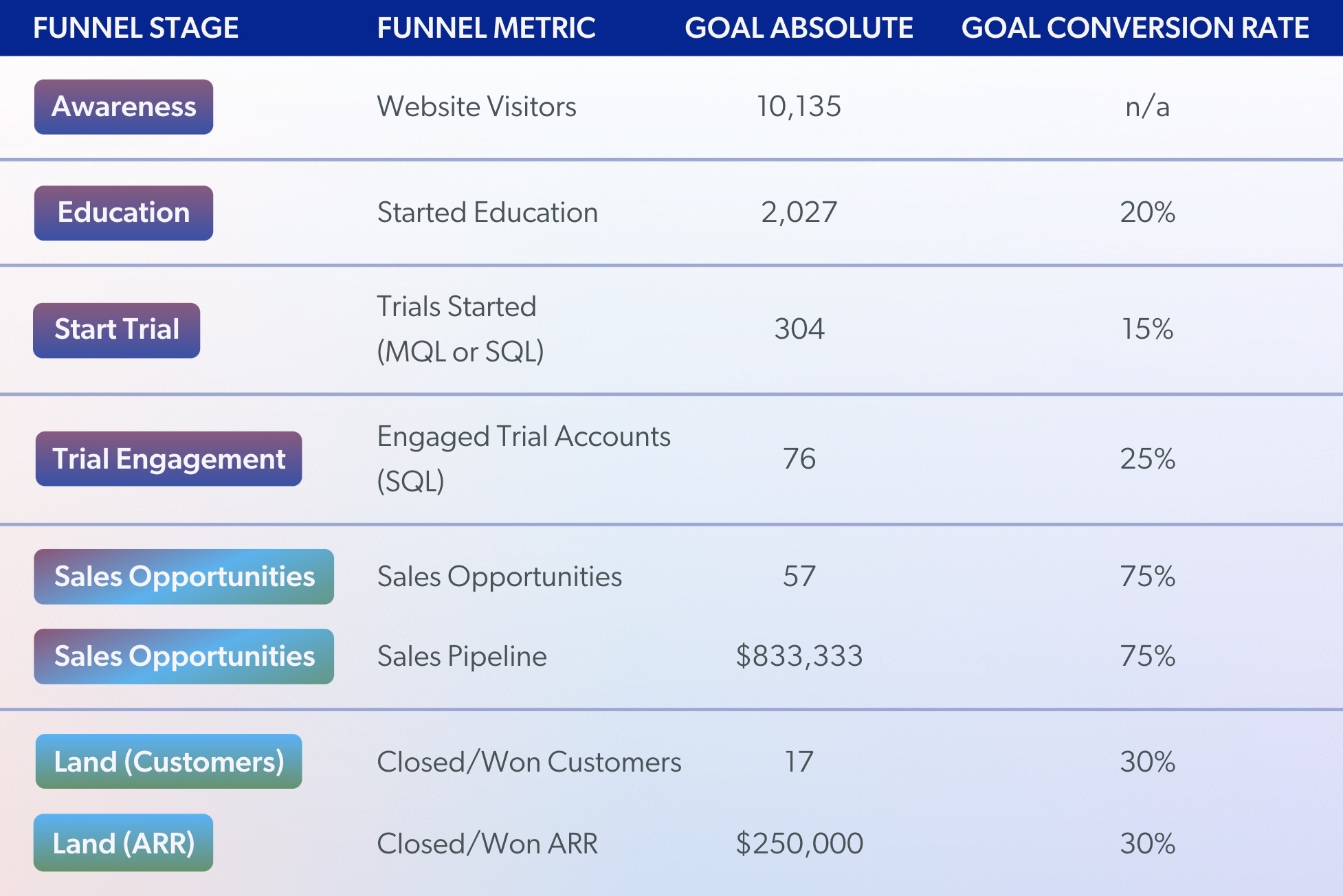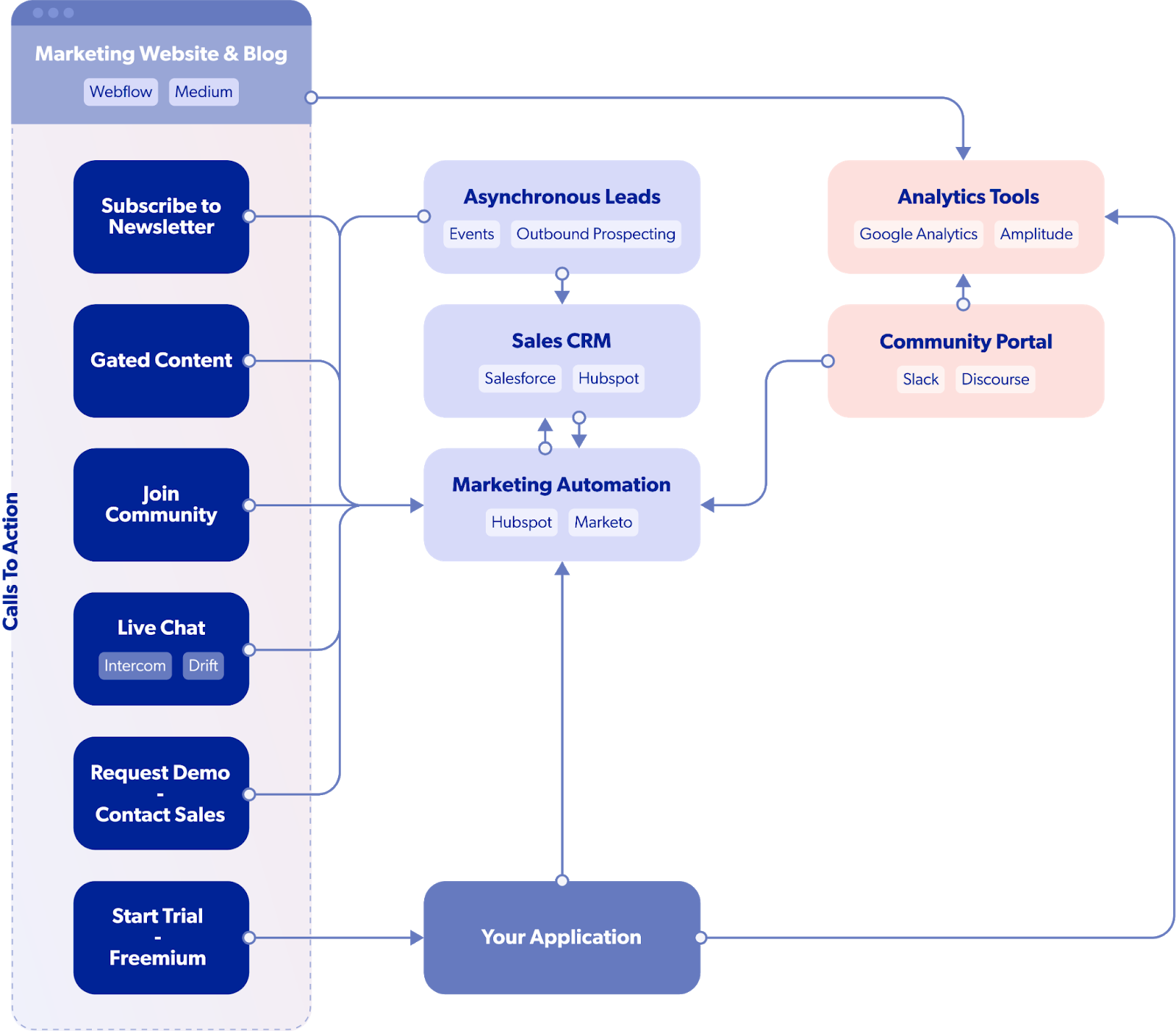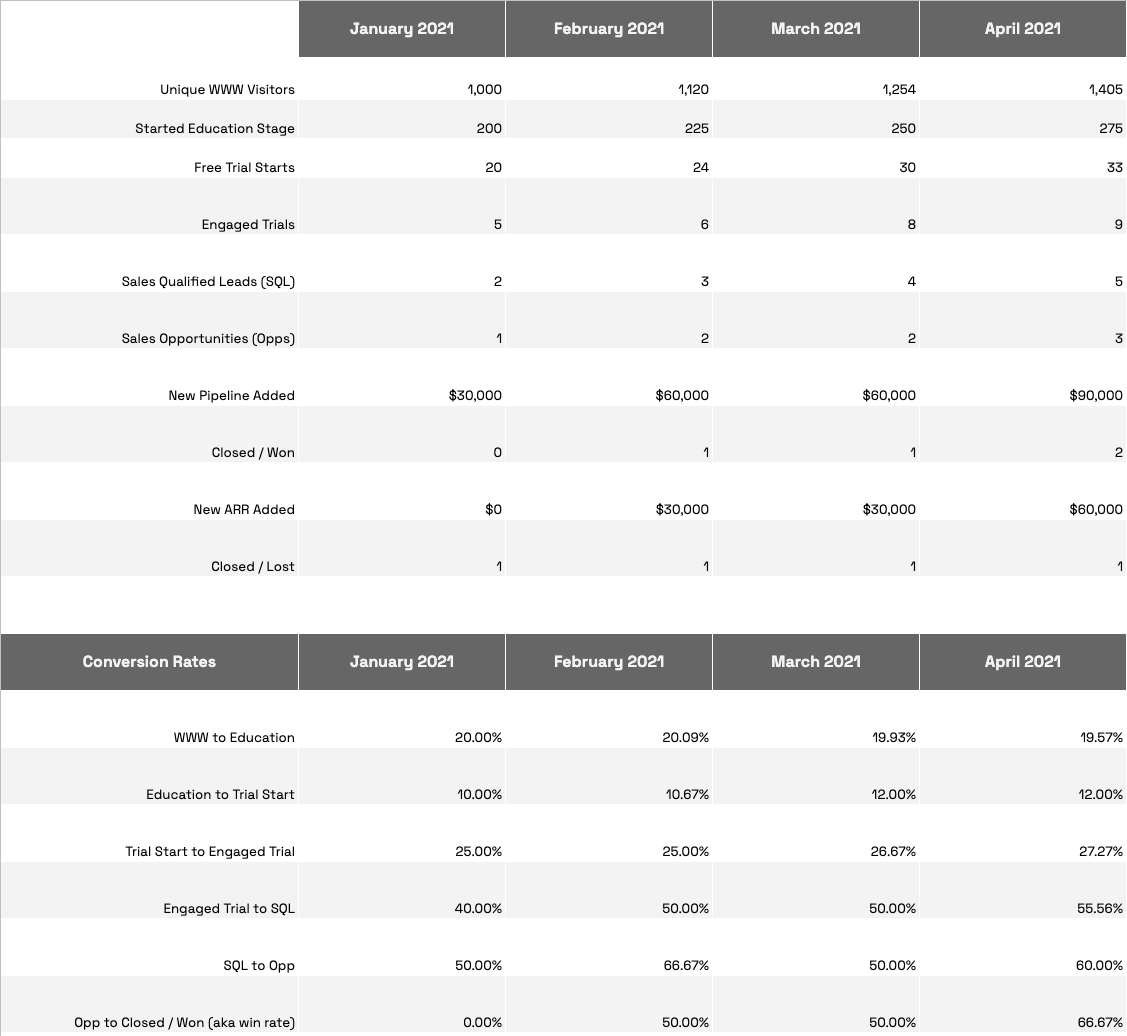
You might have noticed that in our discussion of funnel stages, I didn’t spend a lot of time talking about leads. I didn’t call them out as goals or metrics earlier because leads are more of an abstraction that describes how far down the GTM funnel a USER is. If that makes no sense to you, I’m sorry and I will come back to it in a little bit.
Let’s define a few lead variations. First, the plain old lead is anyone whose contact information your company has acquired. This includes all the contacts you collect at trade shows, all the people who fill out a form on your website (ebook download, webinar registration, newsletter subscription, demo requests, etc). Until you know if they meet the qualification criteria, consider them plain old leads.
A Marketing Qualified lead or MQL is a lead who has passed some qualification criteria. In the early stages, it doesn’t make sense to get too creative with how you define MQL criteria. The idea for now is to separate out the spam and non-product inquiries you’ll get from actual leads you get from your target USERs. On the most restrictive side, you can require a business email (no Gmails) or do a quick LinkedIn check to see if they are legitimate. But don’t be too restrictive — some legitimate prospects use their personal emails to download content and attend webinars. Keep the definition of MQL pretty open at first and make it more restrictive as you learn from experience how to separate out the wheat from the chaff.
A good starter definition for MQLs is any lead that:
A Sales Qualified Lead or SQL is an MQL that exhibits signals indicating that a sales conversation with the lead would be beneficial. Defining and tuning your signals will take some time and experience to get right. Your goal will be to find a definition that minimizes the amount of time your sales team spends on unqualified leads and also make sure your signals aren’t so restrictive that qualified leads aren’t being passed to the sales team.
So what should be your SQL definition? It depends on many factors, including the method by which someone becomes a lead, what actions they’ve taken, and what you’ve learned about your Ideal Customer Profile’s (ICP) buying behavior. Instead of giving you a specific answer then, I’ll give you an example using our favorite character, Anonymous Sandy. When we last saw Sandy in March, she was digging into some educational content. Let’s take a look and see what she’s up to now:
Sandy likes what she reads in your educational content and sees an opportunity to try your product in the summer — say June — once she has more spare cycles and her boss is on summer vacation. She wants to keep up with any of your company news and new blog articles, so she subscribes to your newsletter. Your past experiences inform you that newsletter subscribers at the Education stage are not ready for a sales conversation. Thanks to your marketing operations wizardry, your marketing automation system detects that Sandy is in the Education stage, is a newsletter subscriber, has an acceptable email domain, and thus accurately marks Sandy as an MQL and enrolls her in your monthly newsletter campaign. Over the next several months, she receives your newsletter and clicks through to read your latest blog articles.
Sandy receives your June newsletter and remembers that she wanted to try your product (yay, it’s summer!). She heads over to your website and immediately clicks on the “Start Free Trial” button and creates an account in your product. Your product updates Sandy’s record in your marketing automation system to indicate that she’s created a product account and started a free trial.
Your experience may tell you that starting a free trial is a signal indicating Sandy is ready for a sales conversation. If that’s the case, your marketing automation system will tag Sandy as an SQL and send the lead to your Sales CRM and notify the sales team that they have a new SQL.
Alternatively, your experience may tell you that Sandy starting a trial isn’t enough to make her an SQL. Instead, she needs to complete at least three product milestones to be considered a SQL. Of course, your amazing product documentation, tutorials, examples, intuitive product, and nurture emails have helped Sandy complete three product milestones and experience her Aha! Moment with your product. Your product keeps track of Sandy’s progress and updates your marketing automation system to indicate her product milestone achievements. Once she reaches the third milestone, she will be tagged as an SQL and sent to the sales team.
So… that’s leads.
It’s important to set goals for each funnel stage, and we recommend using the GTM Planner tool to calculate expenses to take your product to market. Typically, you should start by setting an ARR goal for a specific period of time (quarter, half, year). Then you work up the funnel and apply target conversion rates for each stage until you get to the top of your funnel.
The following example table tracks funnel stage metrics, based on a goal for the period of adding $250,000 in new business (land) ARR. It assumes that the average deal size for a new business land transaction is $15,000 and thus 17 new customers need to be added to hit the $250,000 ARR goal. The column Goal Conversion Rate includes conversion rate assumptions, essentially the percentage of users from the previous funnel stage that will successfully enter the current stage.

Each funnel stage should have an owner who’s responsible for setting up, monitoring, and reporting on metrics for that stage. For example, Marketing may own Awareness and Start Trial and be responsible for collecting and reporting on the applicable stage metrics to the rest of the organization. I’ve found it very helpful to keep these metrics, goals, and status (on track, behind, ahead of goal) up to date and easily accessible to the entire organization. This level of visibility promotes an open culture and creates a shared language around the goals for the company, each team, and how each team’s work is impacting the overall business. I also recommend maintaining a report, dashboard, or just a spreadsheet and using it to facilitate discussions in weekly leadership team meetings. Reporting helps you and your team identify funnel challenges that need to be addressed ASAP.
In the next article, we’ll discuss the best marketing technology to invest in and cover important operational considerations. Let’s get ready to serve up all of your great content, capture leads, convert them to SQLs, and make sure we’re capturing all those metrics!
This article assumes you’ve read GTM funnel stages, metrics, & goals and/or understand the common funnel stages for a Modern Enterprise GTM strategy and key metrics like MQLs, SQLs, and Opportunities.
If a highly qualified prospect fills out a form on your marketing website but no one at your company knows about it, is it a lead? Don’t try to answer that. This is a philosophical question that marketers dating back to Socrates (yes, he was the first growth hacker) have wasted countless hours contemplating, debating, and outright fighting about.
The reality is that you’ll need a minimum set of technology and operational rigor in order to maximize the leverage you get out of the amazing messaging, content, campaigns, and elbow grease you’re about to include in your Modern GTM. This article will provide you with a holistic view into the minimum viable MarTech stack for an early-stage company. It will also touch on adjacent sales, product, education, and community systems. First, let’s review and make sure we’re on the same page with some GTM funnel concepts.
Your funnel is how you’re mapping your Modern GTM activities, metrics, and goals with your USER/BUYER journey. As your USERs (typically, it’s not the BUYERs) search for solutions to their problem, they become aware of your product. From there, they educate themselves with your content and documentation, sign up for your free trial, achieve the almighty Aha! moment, and become happy, paying customers who will advocate for your solution with their peers.
It all sounds so simple. Well, thanks to modern technology it is! OK, not really. However, technology will be required and will make your life much easier as you build, serve, manage, and analyze all of your marketing programs and activities.
When considering the kinds of technology to invest in and how much to invest, recognize that:
Or as I like to say, MVESESGTMTS. It rolls off the tongue, doesn’t it?

Website and blog
This might come as a total shock, but you need a marketing website and a blog. The key consideration is what tools you’ll use to build and host your marketing website and blog. I typically recommend Webflow to design, build, and host your site and blog because they offer a powerful UI-based design/development tool for building relatively sophisticated sites that look really good, have animation, and can be powered by a CMS.
While you could create your site without a UI-based tool, Webflow is a pretty small investment and makes it possible for your marketing team (once you hire them) to make most changes to the site without needing product engineering resources. You can also host your blog on Medium to build awareness with your USERs. However, you will likely use your blog to publish content that is rich in SEO keywords and we don’t want your website to miss out on all that SEO juice. A good option is to publish your blog articles on your own blog first and then a few days later post it on your Medium blog that mentions it was previously published on your blog with a backlink. Two birds, one stone.
Live chat
While not a requirement, having live chat on your marketing site can be a great way to engage with site visitors and help them through their journey. Intercom and Drift tend to be the go-to solutions but there are other options out there. Beyond the vendor you choose, the big consideration is how you will manage the chat requests. Most of these tools have bots and offer some level of automation, but to get the value out of these tools, you’ll want a real human responding to inbound chat requests as much as possible.
Marketing automation system
Your marketing automation system will be a central part of your Modern GTM execution. It needs to integrate with your marketing website, sales CRM, product, social media accounts, advertising platforms, and, well, just about everything. It serves as your contact database for leads and customers and powers your marketing emails, lead management, lead scoring, campaign tracking, etc.
To better illustrate, imagine you promote a gated ebook on your marketing website.
Your marketing automation system will:
Long story short, you need a good marketing automation system and I recommend going with a vendor that’s been around a while, such as Hubspot or Marketo.
Sales customer relationship management (CRM)
As the name implies, your sales customer relationship management (CRM) system is more for sales than for marketing. With that said, your marketing team will be heavily involved in the design of the CRM objects and properties, integrating it with the marketing automation system, and most likely using it heavily for reporting. I’ve yet to find an experienced sales representative or executive who does not want to use Salesforce, but there are other options. Like the marketing automation system, I recommend going with an established vendor.
Prospecting and outbound
In an ideal world, our entire target market would start their journey by finding our content while doing a Google search. The reality is, they won’t — especially in the early days. So, you will need to kickstart the process with some good old-fashioned outbound sales and marketing. And to do outbound, you’ll need some tools to prospect (find the contact information for your ICP personas) and to automate your outreach. Tools like Outreach, Orum (an Unusual Ventures portfolio company), ZoomInfo, and LinkedIn Sales Navigator are all great options to explore.
Community management
You need a platform to operate your online community. Many B-to-B software companies use Slack; Discourse (discourse.org) is also a good option because it’s web-based and gives you the option to make some of the discussions publicly available to boost SEO and build awareness.
Reporting and dashboards
In an ideal world, you’d have a centralized data warehouse that all of your various GTM metrics could call home. You’d have a slick reporting tool that serves up data visualizations and dashboards from the data in your warehouse and even supports ad hoc analysis. But the world is cruel sometimes, and I’m guessing you’ll rely on a combination of spreadsheets and Salesforce reports and dashboards. This approach works fine for now but just takes some manual effort to export the metrics from the various sources regularly and bring them into the spreadsheet (and attempt to join the data). Once you’ve got this system set up, it’s pretty painless to keep up to date.


How to collect marketing metrics
On the marketing side, you’ll need to integrate the following tools into your website via each vendor’s Javascript snippet to collect the metrics that you’ll be using in your reports and dashboards:
While you may not be thinking about advertising just yet, including tracking snippets from Google Analytics, LinkedIn, Twitter, and Facebook on your site now will allow you to start building retargeting audiences on these platforms. Tracking insights will come in handy when you’re ready to run ads — you’ll be able to create campaigns that only advertise to people who have visited your site.
Ad platforms allow you to refine your retargeting audience for any campaign, such as “Visited 3 pages” or “Hasn’t Converted Yet” or “Downloaded Ebook but Hasn’t Signed Up for a Trial.” Long story short: Set up tracking snippets now to help you run some very targeted campaigns in the future!
On the product side, you’ll likely need to invest in a tool such as Amplitude, Heap, MixPanel, etc. to collect the product engagement metrics.
T-shirt gun shooter
OK, this isn’t required and is probably a big waste of money. But still, wouldn’t it be cool to shoot T-shirts to people at the next big trade show?
